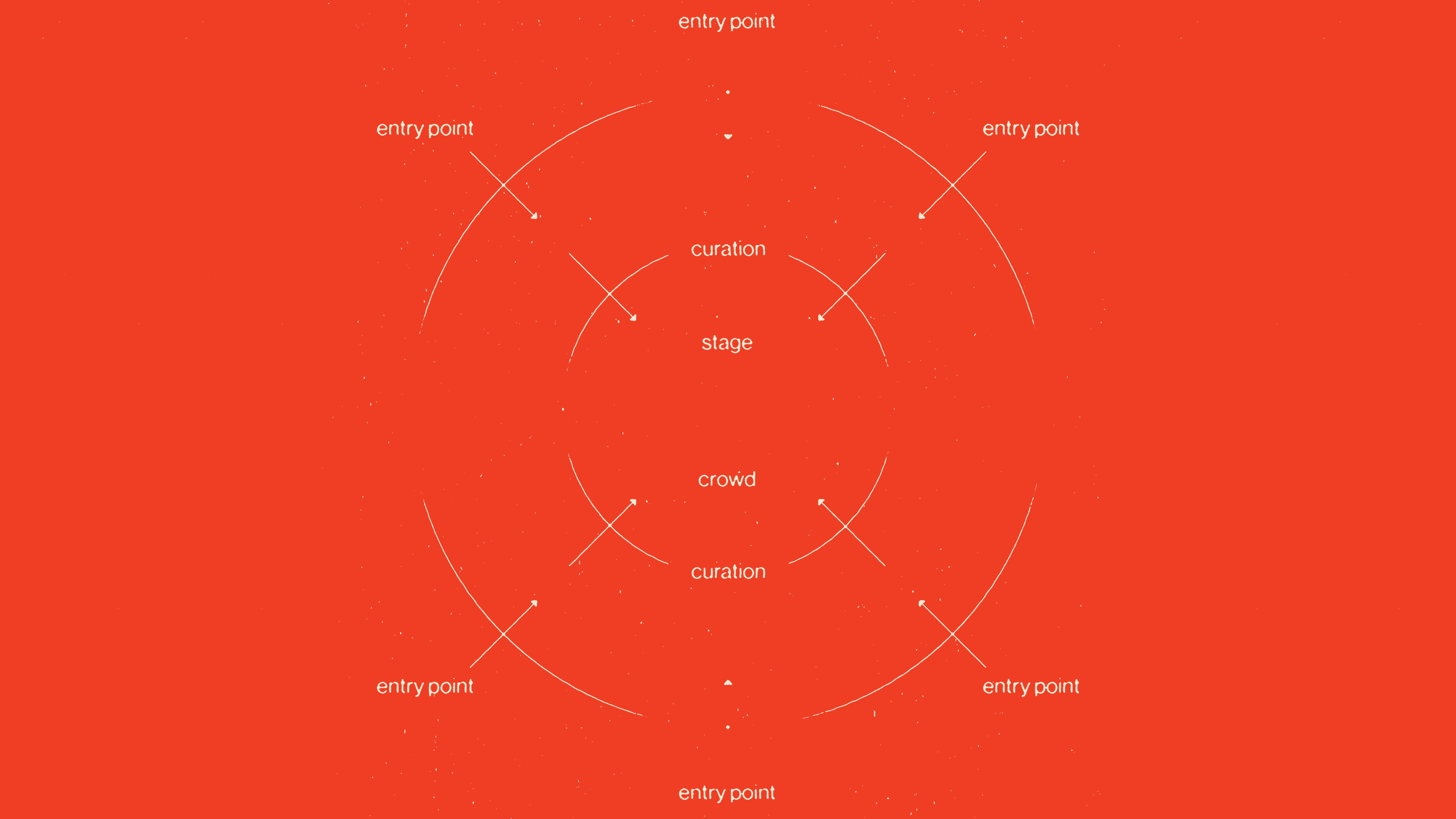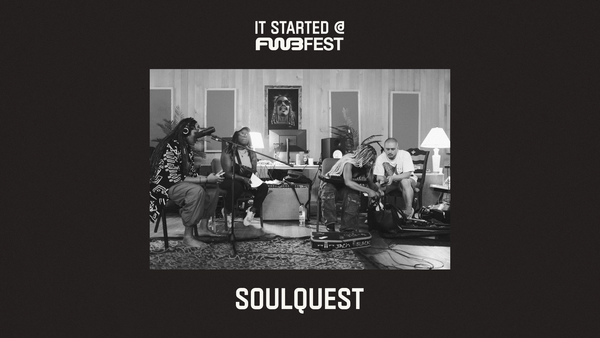- Ariel LeBeau
- Austin Robey
- David Blumenstein
- David Ehrlichman
- David Kerr
- Devon Moore
- Dexter Tortoriello
- Drew Coffman
- Drew Millard
- Eileen Isagon Skyers
- FWB Staff
- Greg Bresnitz
- Greta Rainbow
- Ian Rogers
- Jessica Klein
- Jose Mejia
- Kelani Nichole
- Kelsie Nabben
- Kevin Munger
- Khalila Douze
- Kinjal Shah
- Lindsay Howard
- Maelstrom
- Marc Moglen
- Marvin Lin
- Mary Carreon
- Matt Newberg
- Mike Pearl
- Moyosore Briggs
- Nicole Froio
- Ruby Justice Thelot
- Simon Hudson
- Steph Alinsug
- The Blockchain Socialist
- Willa Köerner
- Yana Sosnovskaya
- Yancey Strickler
- iz

Tue Apr 23 2024
Don’t Kill The Vibe: A reflection on the success of FWB's decentralized events program
Everyone knows that bottlenecks are a vibe killer. When we began the FWB Cities program–since renamed the Event Keys program–in 2021, we had the wild ambition to kick off with a commitment to host three distinct events a month across the globe. That amounts to 36 individual global events annually produced by the core team and attended by a fully decentralized membership of internet friends and their friends, and their friend’s friends, and so on.
Los Angeles, London, and New York were our first activations under the new program, following the success of earlier events in Paris and Miami. We started in cities with the most engaged membership nodes with quick plans to scale. However confining creative direction and decision-making to FWB’s core team created an immediate bottleneck, not only impeding the nuanced process of event planning and securing talent but also (perversely) stifling our ability to move efficiently. Our centralization bottleneck was killing the vibe, inadvertently breaking the cardinal rule of events: don’t kill the vibe.
Our resolution? Implement a decentralization solution that would align our emerging technology philosophy with our cultural philosophy. The result is our Event Pattern Language.
This initiative not only democratized event organization within FWB but also set a precedent for how other decentralized autonomous organizations (DAOs) might scale their events and programming. Since we originally wrote Event Pattern Language in 2021, our Event Keys program has facilitated over 200 activations across the globe, with more in production.
We’re publishing our Event Pattern Language for the first time. This document has historically served as reference material for members applying to the Event Keys program, but we think this pattern language should be in the public domain. We’ve updated the patterns to reflect cultural evolutions and continued learning in the three years since its original writing. We hope it resonates, and we invite you to use this pattern language as a starting point for an event pattern language for your community. See you IRL, soon.
P.S. Collect the PDF on Base via Zora.
Introduction
As FWB expands from URL into IRL, we need a cohesive and comprehensive language for event programming. Inspired by the seminal 70s text, The Timeless Way of Building, by Christopher Alexander, our goal is to build an Events Pattern Language to guide our decentralized event efforts with a global programming strategy that is both distinctly FWB and individualized by geography and place.
Pattern languages are repeatable and flexible coordination practices–or patterns–that inform design principles. The concept emerged in the 1970s and was popularized by architect Christopher Alexander, whose book The Timeless Way of Building persists as an influential text. While the original application of pattern languages was within architectural and urban design practices, pattern languages are adaptable to various, specific design situations, including many contexts other than physical infrastructure.

Pattern Language - A Brief Overview*
- Every society that is alive and whole has its own unique and distinct pattern language.
- The essential feature of a pattern is that it forms the basis for a shared community agreement, allowing members to discuss, then build, while maintaining a level of coherence.
- Patterns are repeatable actions that happen organically in response to space.
- The accumulation of those actions form patterns that can be codified into shared language.
- A pattern must characterize the problems it is meant to solve, the context or situation where these problems arise, and the conditions under which the proposed solutions can be recommended.
- Often these problems arise from a conflict of different interests or "forces." A pattern emerges as a dialogue to balance the forces, leading to a decision.
- Patterns are a snapshot in time and should be revisited to ensure cultural relevance.
- A pattern language should make people feel human and alive.
- A pattern language is an attempt to express the deeper wisdom of aliveness within a particular field of human endeavor. Through a set of interconnected patterns, we might experience a sense of wholeness, spirit, or grace that varies in form, but is precise and empirically verifiable.
*Adapted from Christopher Alexander’s The Timeless Way of Building

FWB’s Event Pattern Language has four components:
- Value Patterns
- Programming Patterns
- Location Patterns
- People Patterns

Value Patterns
Where do you belong?
FWB’s values should be felt, seen, and heard at every event. Treat an FWB event like a microcosm of our universe: it embodies what we collectively stand for when done well.
Whether intentionally or unintentionally, many “tech” events lean into stale norms, mainly heteronormative, which permeates the vibe from attendees to talent to the event space itself. This normativity often engenders a sense of exclusion or (worse) alienation for anybody who falls outside this demographic (most people.)
As an opinionated scene, our events should reflect the people, cultures, and tastes that make and keep our community trend-setting. Everyone should feel comfortable enough to connect to build a thriving, sustained community. Even when alone, a sense of ease must be the default.
Strategies
- Encourage kindness, prioritize consent and accessibility, and maintain zero-tolerance for harassment of any kind to create a safe space for everyone.
- Read and incorporate the values of our Manifesto and Code of Conduct. These are the backbone of our community, and we adhere to them at all times.
- Publish event descriptions and materials in multiple languages when relevant.
- Embrace outliers.

Programming Patterns
What do you think?
Peak event programming demonstrates a curated point of view that signals where we invest our resources, who we align with, and what we value. It tells the story of where we are situated, highlights our values and community, and showcases our cultural partners whenever applicable. We believe that events, big or small, can be transformative experiences that bring people together so go deeper. There will always be someone who appreciates it.
Talent
It’s an honor to book and work with talent. Event producers must respect and protect talent’s time, energy, and vision to receive their work's truest, undiluted versions. This is especially true for FWB, where many creatives first experience our community by participating in an event.
Local Lens
An FWB event should always feel authentic to our values and speak to its specificity. Programming can’t exist in isolation or it runs the risk of being wholly out of touch or irrelevant. It must be knowingly impacted by and adapt to its cultural, social, and geographic context. By embracing this reality, event producers create experiences that resonate, drive connection and retention, and feel valuable.
Money & Time
Money is good; access is better. Too often, event producers spend large sums of money, thinking that the biggest names in the shiniest venue make an event stand out. Anyone with enough cash can produce something that carries some cultural weight, but more often than not, it does not successfully differentiate itself or present an authentic point of view.
The best opportunities come to event producers with hard work, rigorous planning, and good timing. Leave room for magic by staying organized and prepared enough to get lucky at the last moment.
Series
Scaling events is not for the faint of heart. Whether launching a one-off or a series, event producers are responsible for programmatic cohesion, experiential consistency, and community alignment. It’s a gentle balance to uphold quality while reducing the blockers a centralized decision-making process creates. We encourage event producers to imagine their ideal event series endpoint for a holistic perspective on how to approach building an overarching theme or narrative.
Strategies
- Reflect the world we live in and want to flourish through the diversity of talent and guests across all forms of identity.
- Engage local stakeholders, partners, organizations, and community leaders whenever possible.
- Account for cultural and dietary restrictions or considerations whenever food is involved. No one should feel that their food preferences are secondary.
- Avoid the lowest common denominator; inspire joy and confidence with rigor, nuance, and value.
- Create relevant printed materials (i.e., menus, schedule, playlists) to which attendees can refer and keep as a souvenir.
- Provide talent with a giveaway or small token of appreciation, and always pay on time.
- Build unstructured time after a focal point for guests to mingle and reflect.
- Leave room for magic.
- Think backwards.

Location Patterns
Why are you here?
The right space sets the stage for connection. It’s easy to overlook how much consideration choosing a space requires and even easier to fall into the trap of selecting a venue and neighborhood based entirely on convenience and popularity. All cities have culturally rich, hidden gems and lesser-known hotspots beyond the well-worn, tried and tested haunts.
And, of course, to successfully vibe-max, a venue or event space’s core capacities and staff must support Value Patterns and Programming Patterns.
Strategies
- Ensure that event host(s) and staff are reasonably visible and available, providing hospitality that aligns with the event’s context.
- Consider, adjust, and signal the constraints and limitations of an event space to ensure all attendees can meet basic biological and safety needs.
- Accessibility of the event via public transportation
- Gender neutral restrooms
- Reasonable accommodations for visible and non-visible disabilities or impairments
- Door staff, security, and bar staff knowledge equipped for emergencies or conflict
- Choose spaces that elevate the programming content and context.
- Music-focused nights must be held in venues with a great sound system.
- Lectures must have good sightlines, comfortable seating, and a sound system that ensures the audience can hear without straining.
- Culinary events must be presented in clean spaces with plenty of room for people to enjoy their food and each other.

People Patterns
Who do you know?
At good parties, you already know everyone. At great parties, you want to know everyone. IYKYK. Good guest curation and a thoughtful RSVP experience have the potential to satisfy our desire for a sense of belonging and recognition. Event producers should review the guestlist in real-time before the event and consider the kinds of conversations, connections, and glances afforded by who's there.
Online Communities
Transitioning from IRL to URL experiences is crucial to deepen bonds, inspire new connections, drive engagement, and build momentum for future events. Event producers should focus on creating opportunities with just enough friction for new and old faces to connect authentically.
For crypto-native communities like FWB, event producers are encouraged to leverage non/fungible tokens and pull on the thread that inherently ties holders together. Don't forget to throw in some added benefits.
Strategies
- Treat RSVP with intention.
- Inject enough magic and detail into the event flyer and description to entice guests.
- Indicate the location clearly or share the location on time for a secret path.
- Send reminders proactively before the event and a thank you note afterward.
- Ensure a token-gated RSVP works correctly and provide non-crypto options, too.
- Plan for attrition.
- Strategize the guest list.
- Tap on friends of friends.
- Save guest list spots for local organizations, event partners, and notable tastemakers to share with their network and communities.
- Triple-check that your VIPs and their +1s are actually on the list.
- Make the door a moment.
- Hire a door person who (seemingly) knows everyone and the space well.
- Use wristbands or a stamp to avoid entry and exit confusion.
- Bridge URL <> IRL connections.
- Create pre-event URL/IRL opportunities for new members to connect and partake in community "rituals."
- Tap on OG heads to welcome newbies at events.
- Remember when you were new?
- If you see a stranger, say what's up.
- If they're not your vibe, connect them to the right person.
---
Artwork by Leith Benkhedda


